ECON 6000 - Schmeckt Gut Case: Economic Principles & Decisions
VerifiedAdded on 2023/06/13
|10
|1838
|345
Report
AI Summary
This report analyzes the economic principles behind decision-making using the Schmeckt Gut case study. It employs linear regression to assess the impact of store expansion and tariff rates on energy bar demand. The analysis reveals a strong positive correlation between the number of stores and demand, while tariff rates show a negative but statistically insignificant impact. Furthermore, the report discusses the benefits of free trade and potential distortions from trade regulations, highlighting the importance of international trade for companies like Schmeckt Gut. The document also includes relevant graphs and regression outputs to support its findings. Desklib provides a platform for students to access this and similar assignments for their study needs.
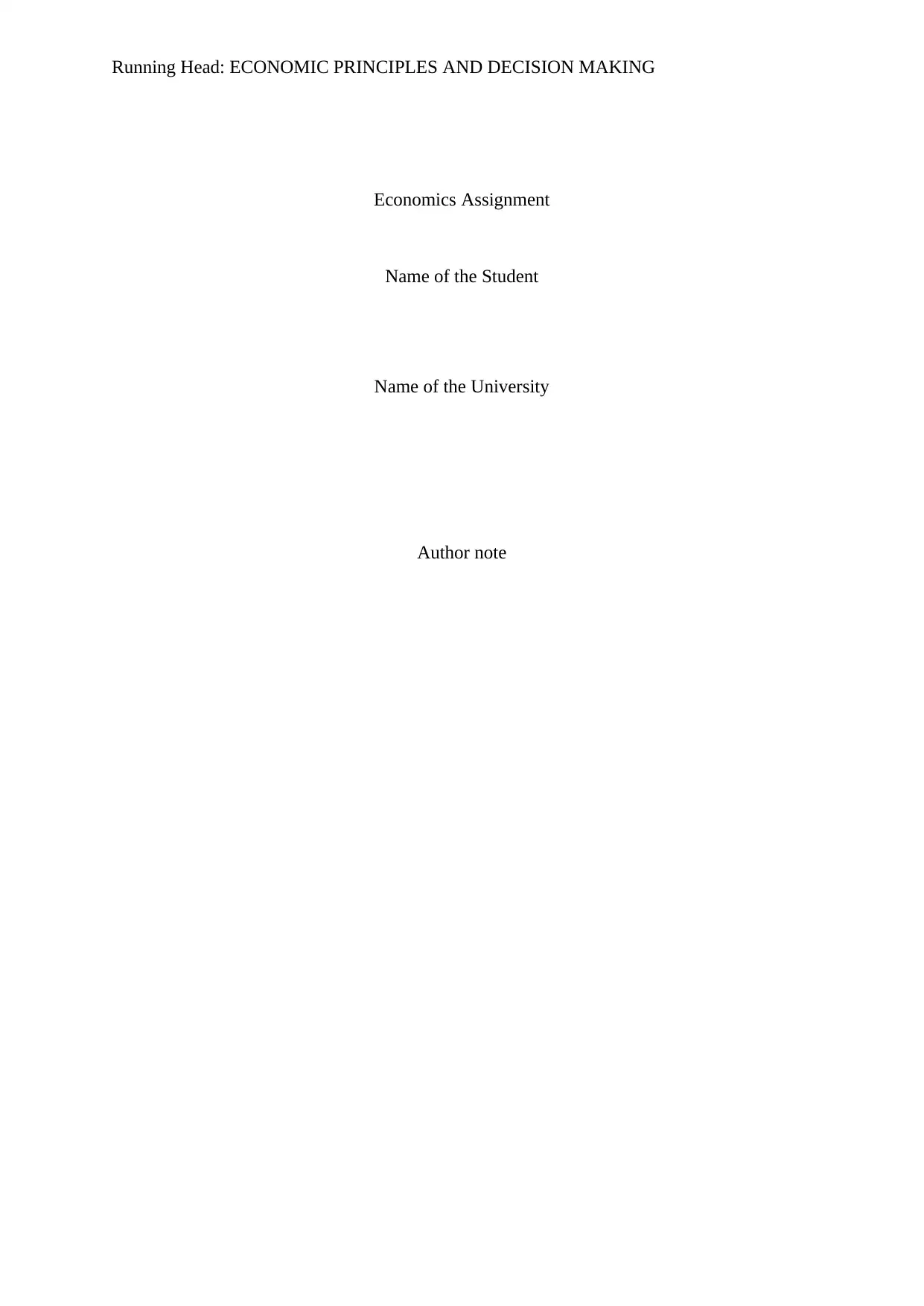
Running Head: ECONOMIC PRINCIPLES AND DECISION MAKING
Economics Assignment
Name of the Student
Name of the University
Author note
Economics Assignment
Name of the Student
Name of the University
Author note
Paraphrase This Document
Need a fresh take? Get an instant paraphrase of this document with our AI Paraphraser
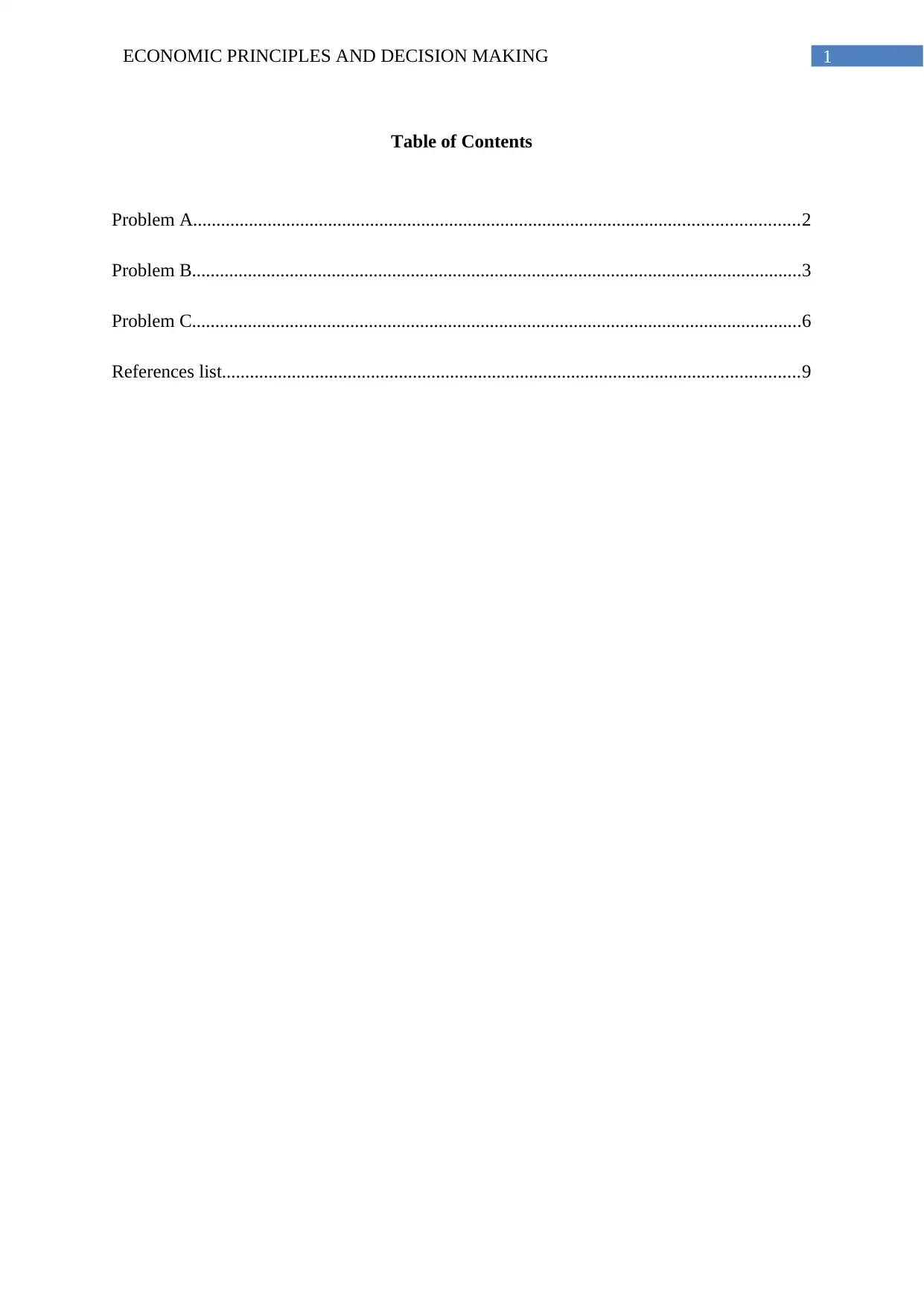
1ECONOMIC PRINCIPLES AND DECISION MAKING
Table of Contents
Problem A..................................................................................................................................2
Problem B...................................................................................................................................3
Problem C...................................................................................................................................6
References list............................................................................................................................9
Table of Contents
Problem A..................................................................................................................................2
Problem B...................................................................................................................................3
Problem C...................................................................................................................................6
References list............................................................................................................................9
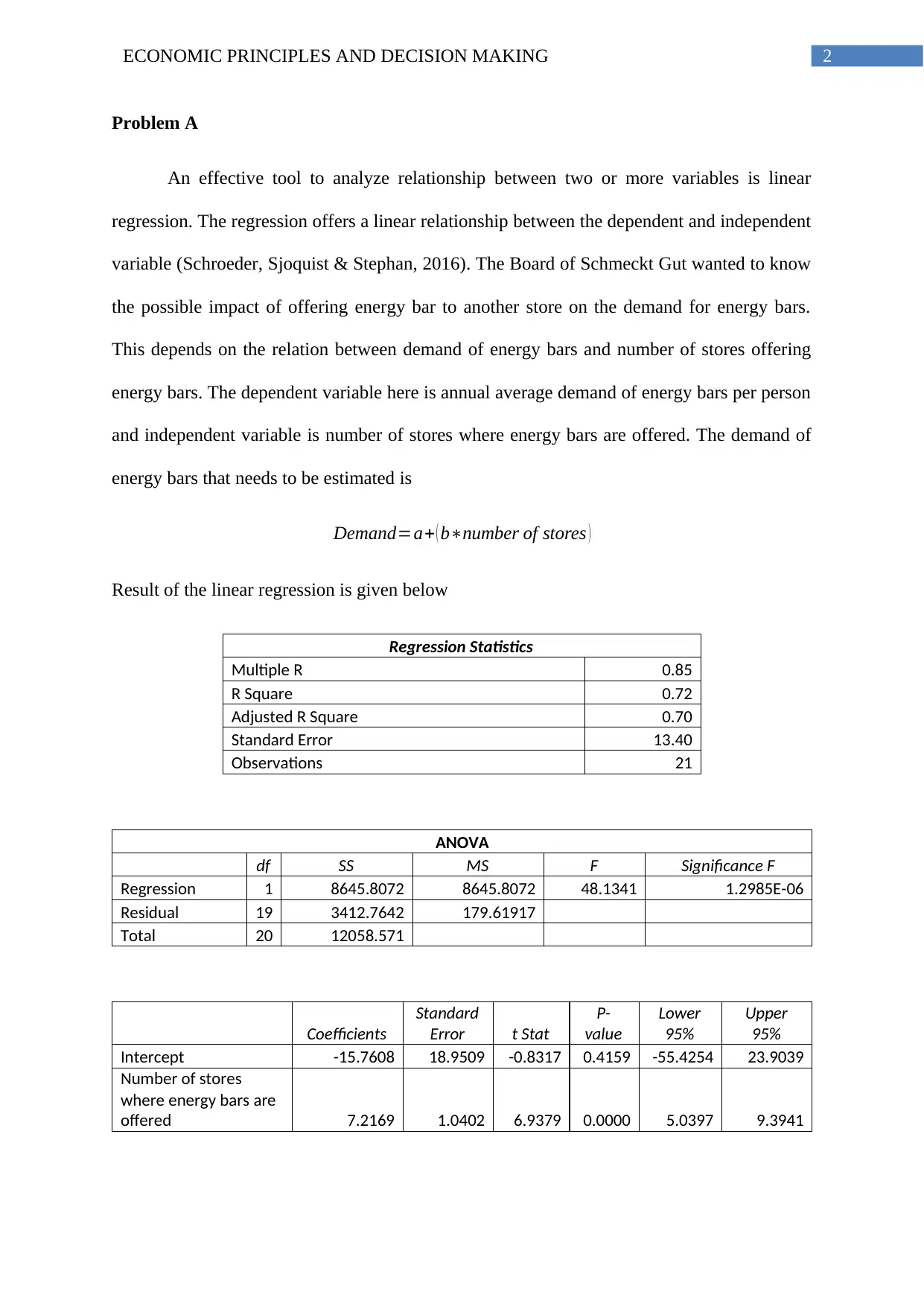
2ECONOMIC PRINCIPLES AND DECISION MAKING
Problem A
An effective tool to analyze relationship between two or more variables is linear
regression. The regression offers a linear relationship between the dependent and independent
variable (Schroeder, Sjoquist & Stephan, 2016). The Board of Schmeckt Gut wanted to know
the possible impact of offering energy bar to another store on the demand for energy bars.
This depends on the relation between demand of energy bars and number of stores offering
energy bars. The dependent variable here is annual average demand of energy bars per person
and independent variable is number of stores where energy bars are offered. The demand of
energy bars that needs to be estimated is
Demand=a+ ( b∗number of stores )
Result of the linear regression is given below
Regression Statistics
Multiple R 0.85
R Square 0.72
Adjusted R Square 0.70
Standard Error 13.40
Observations 21
ANOVA
df SS MS F Significance F
Regression 1 8645.8072 8645.8072 48.1341 1.2985E-06
Residual 19 3412.7642 179.61917
Total 20 12058.571
Coefficients
Standard
Error t Stat
P-
value
Lower
95%
Upper
95%
Intercept -15.7608 18.9509 -0.8317 0.4159 -55.4254 23.9039
Number of stores
where energy bars are
offered 7.2169 1.0402 6.9379 0.0000 5.0397 9.3941
Problem A
An effective tool to analyze relationship between two or more variables is linear
regression. The regression offers a linear relationship between the dependent and independent
variable (Schroeder, Sjoquist & Stephan, 2016). The Board of Schmeckt Gut wanted to know
the possible impact of offering energy bar to another store on the demand for energy bars.
This depends on the relation between demand of energy bars and number of stores offering
energy bars. The dependent variable here is annual average demand of energy bars per person
and independent variable is number of stores where energy bars are offered. The demand of
energy bars that needs to be estimated is
Demand=a+ ( b∗number of stores )
Result of the linear regression is given below
Regression Statistics
Multiple R 0.85
R Square 0.72
Adjusted R Square 0.70
Standard Error 13.40
Observations 21
ANOVA
df SS MS F Significance F
Regression 1 8645.8072 8645.8072 48.1341 1.2985E-06
Residual 19 3412.7642 179.61917
Total 20 12058.571
Coefficients
Standard
Error t Stat
P-
value
Lower
95%
Upper
95%
Intercept -15.7608 18.9509 -0.8317 0.4159 -55.4254 23.9039
Number of stores
where energy bars are
offered 7.2169 1.0402 6.9379 0.0000 5.0397 9.3941
⊘ This is a preview!⊘
Do you want full access?
Subscribe today to unlock all pages.

Trusted by 1+ million students worldwide
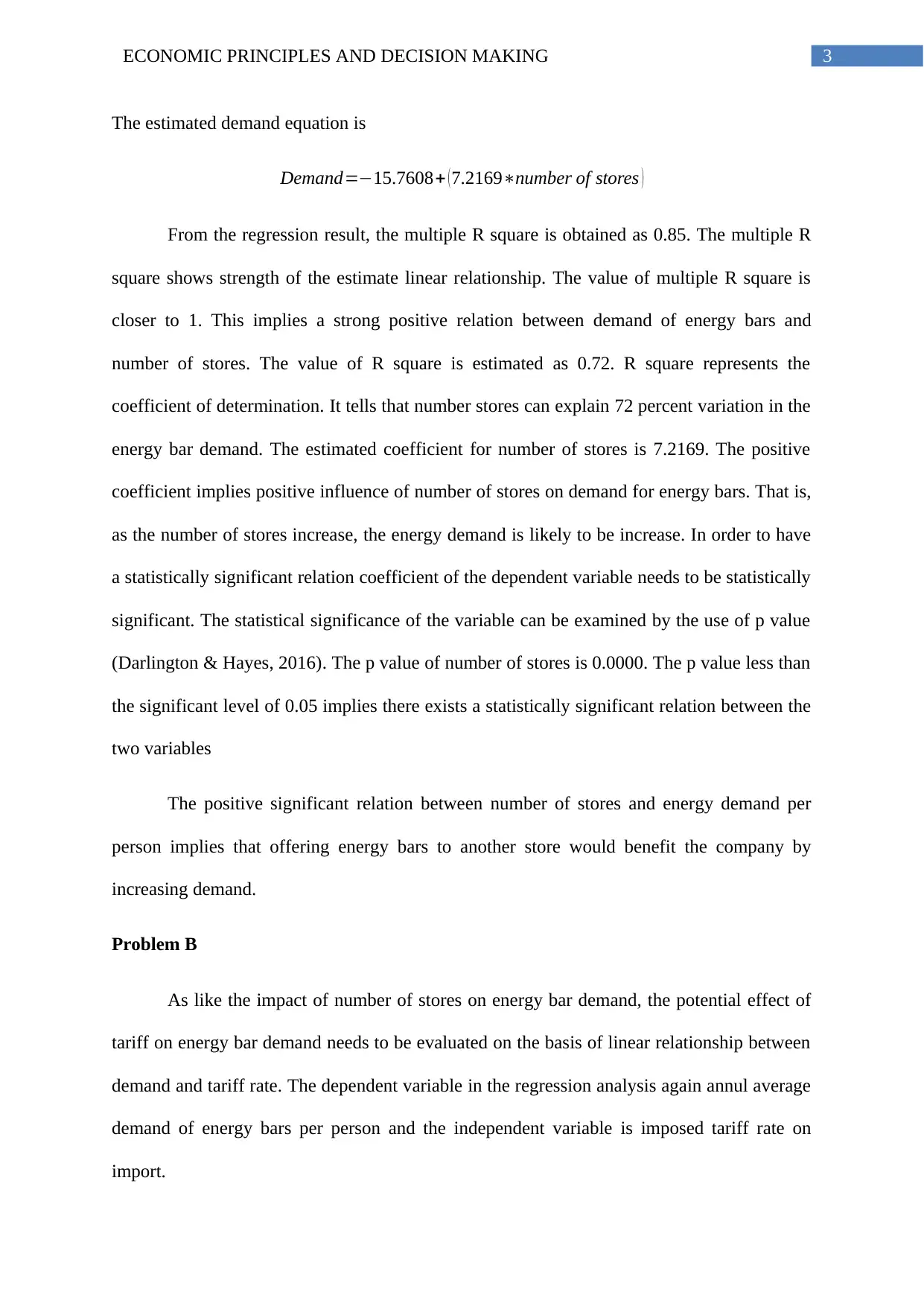
3ECONOMIC PRINCIPLES AND DECISION MAKING
The estimated demand equation is
Demand=−15.7608+ (7.2169∗number of stores )
From the regression result, the multiple R square is obtained as 0.85. The multiple R
square shows strength of the estimate linear relationship. The value of multiple R square is
closer to 1. This implies a strong positive relation between demand of energy bars and
number of stores. The value of R square is estimated as 0.72. R square represents the
coefficient of determination. It tells that number stores can explain 72 percent variation in the
energy bar demand. The estimated coefficient for number of stores is 7.2169. The positive
coefficient implies positive influence of number of stores on demand for energy bars. That is,
as the number of stores increase, the energy demand is likely to be increase. In order to have
a statistically significant relation coefficient of the dependent variable needs to be statistically
significant. The statistical significance of the variable can be examined by the use of p value
(Darlington & Hayes, 2016). The p value of number of stores is 0.0000. The p value less than
the significant level of 0.05 implies there exists a statistically significant relation between the
two variables
The positive significant relation between number of stores and energy demand per
person implies that offering energy bars to another store would benefit the company by
increasing demand.
Problem B
As like the impact of number of stores on energy bar demand, the potential effect of
tariff on energy bar demand needs to be evaluated on the basis of linear relationship between
demand and tariff rate. The dependent variable in the regression analysis again annul average
demand of energy bars per person and the independent variable is imposed tariff rate on
import.
The estimated demand equation is
Demand=−15.7608+ (7.2169∗number of stores )
From the regression result, the multiple R square is obtained as 0.85. The multiple R
square shows strength of the estimate linear relationship. The value of multiple R square is
closer to 1. This implies a strong positive relation between demand of energy bars and
number of stores. The value of R square is estimated as 0.72. R square represents the
coefficient of determination. It tells that number stores can explain 72 percent variation in the
energy bar demand. The estimated coefficient for number of stores is 7.2169. The positive
coefficient implies positive influence of number of stores on demand for energy bars. That is,
as the number of stores increase, the energy demand is likely to be increase. In order to have
a statistically significant relation coefficient of the dependent variable needs to be statistically
significant. The statistical significance of the variable can be examined by the use of p value
(Darlington & Hayes, 2016). The p value of number of stores is 0.0000. The p value less than
the significant level of 0.05 implies there exists a statistically significant relation between the
two variables
The positive significant relation between number of stores and energy demand per
person implies that offering energy bars to another store would benefit the company by
increasing demand.
Problem B
As like the impact of number of stores on energy bar demand, the potential effect of
tariff on energy bar demand needs to be evaluated on the basis of linear relationship between
demand and tariff rate. The dependent variable in the regression analysis again annul average
demand of energy bars per person and the independent variable is imposed tariff rate on
import.
Paraphrase This Document
Need a fresh take? Get an instant paraphrase of this document with our AI Paraphraser
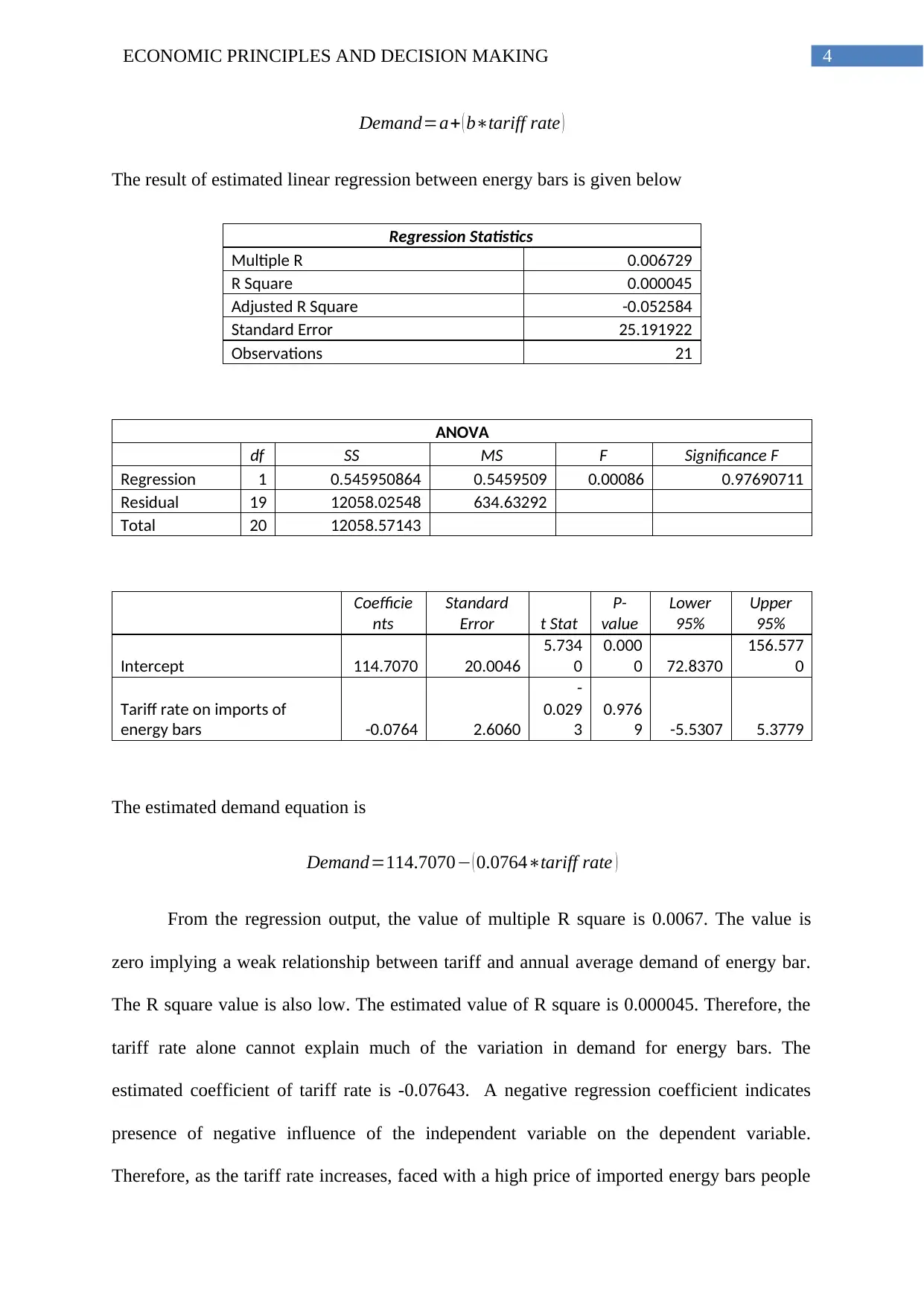
4ECONOMIC PRINCIPLES AND DECISION MAKING
Demand=a+ ( b∗tariff rate )
The result of estimated linear regression between energy bars is given below
Regression Statistics
Multiple R 0.006729
R Square 0.000045
Adjusted R Square -0.052584
Standard Error 25.191922
Observations 21
ANOVA
df SS MS F Significance F
Regression 1 0.545950864 0.5459509 0.00086 0.97690711
Residual 19 12058.02548 634.63292
Total 20 12058.57143
Coefficie
nts
Standard
Error t Stat
P-
value
Lower
95%
Upper
95%
Intercept 114.7070 20.0046
5.734
0
0.000
0 72.8370
156.577
0
Tariff rate on imports of
energy bars -0.0764 2.6060
-
0.029
3
0.976
9 -5.5307 5.3779
The estimated demand equation is
Demand=114.7070− ( 0.0764∗tariff rate )
From the regression output, the value of multiple R square is 0.0067. The value is
zero implying a weak relationship between tariff and annual average demand of energy bar.
The R square value is also low. The estimated value of R square is 0.000045. Therefore, the
tariff rate alone cannot explain much of the variation in demand for energy bars. The
estimated coefficient of tariff rate is -0.07643. A negative regression coefficient indicates
presence of negative influence of the independent variable on the dependent variable.
Therefore, as the tariff rate increases, faced with a high price of imported energy bars people
Demand=a+ ( b∗tariff rate )
The result of estimated linear regression between energy bars is given below
Regression Statistics
Multiple R 0.006729
R Square 0.000045
Adjusted R Square -0.052584
Standard Error 25.191922
Observations 21
ANOVA
df SS MS F Significance F
Regression 1 0.545950864 0.5459509 0.00086 0.97690711
Residual 19 12058.02548 634.63292
Total 20 12058.57143
Coefficie
nts
Standard
Error t Stat
P-
value
Lower
95%
Upper
95%
Intercept 114.7070 20.0046
5.734
0
0.000
0 72.8370
156.577
0
Tariff rate on imports of
energy bars -0.0764 2.6060
-
0.029
3
0.976
9 -5.5307 5.3779
The estimated demand equation is
Demand=114.7070− ( 0.0764∗tariff rate )
From the regression output, the value of multiple R square is 0.0067. The value is
zero implying a weak relationship between tariff and annual average demand of energy bar.
The R square value is also low. The estimated value of R square is 0.000045. Therefore, the
tariff rate alone cannot explain much of the variation in demand for energy bars. The
estimated coefficient of tariff rate is -0.07643. A negative regression coefficient indicates
presence of negative influence of the independent variable on the dependent variable.
Therefore, as the tariff rate increases, faced with a high price of imported energy bars people
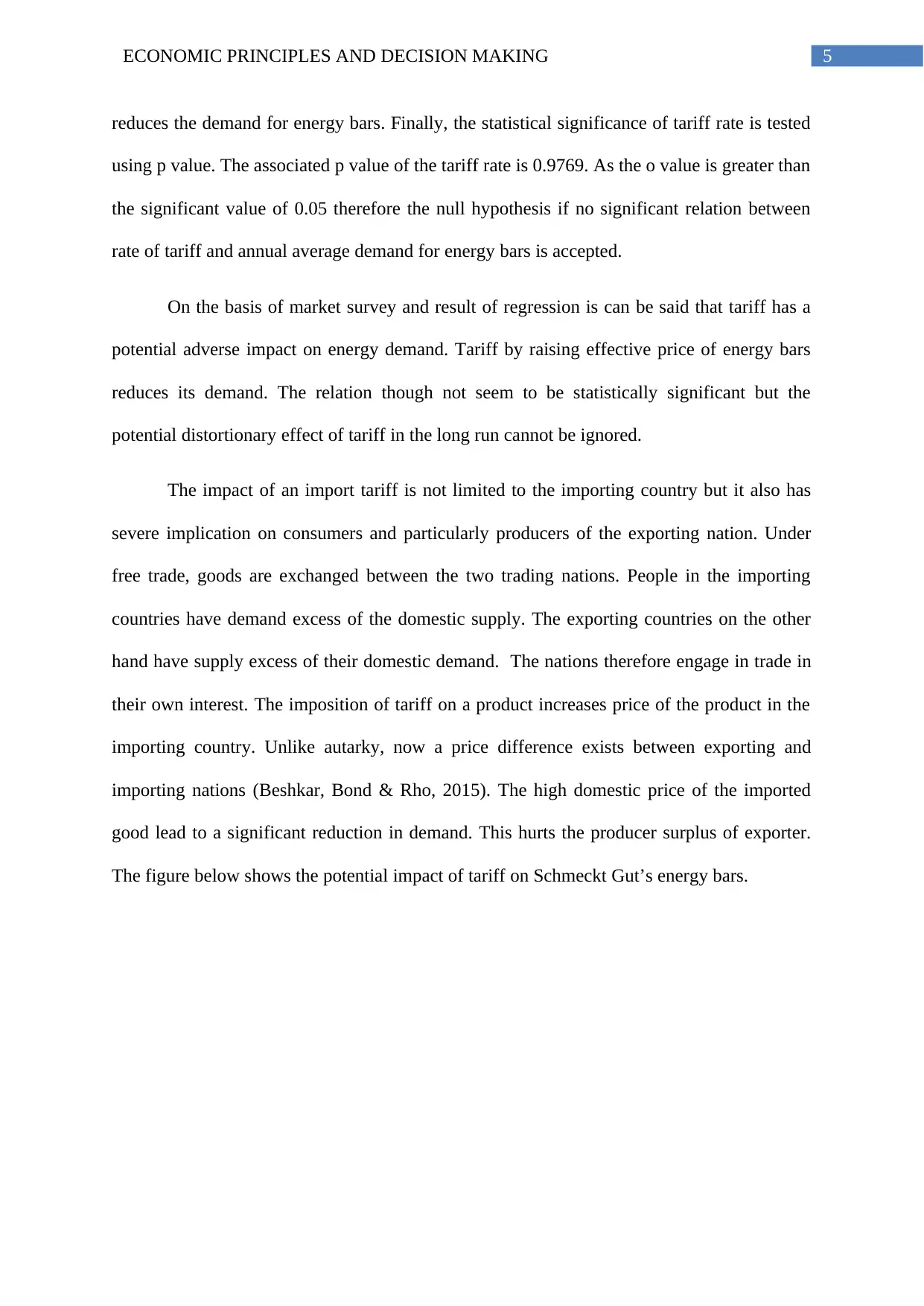
5ECONOMIC PRINCIPLES AND DECISION MAKING
reduces the demand for energy bars. Finally, the statistical significance of tariff rate is tested
using p value. The associated p value of the tariff rate is 0.9769. As the o value is greater than
the significant value of 0.05 therefore the null hypothesis if no significant relation between
rate of tariff and annual average demand for energy bars is accepted.
On the basis of market survey and result of regression is can be said that tariff has a
potential adverse impact on energy demand. Tariff by raising effective price of energy bars
reduces its demand. The relation though not seem to be statistically significant but the
potential distortionary effect of tariff in the long run cannot be ignored.
The impact of an import tariff is not limited to the importing country but it also has
severe implication on consumers and particularly producers of the exporting nation. Under
free trade, goods are exchanged between the two trading nations. People in the importing
countries have demand excess of the domestic supply. The exporting countries on the other
hand have supply excess of their domestic demand. The nations therefore engage in trade in
their own interest. The imposition of tariff on a product increases price of the product in the
importing country. Unlike autarky, now a price difference exists between exporting and
importing nations (Beshkar, Bond & Rho, 2015). The high domestic price of the imported
good lead to a significant reduction in demand. This hurts the producer surplus of exporter.
The figure below shows the potential impact of tariff on Schmeckt Gut’s energy bars.
reduces the demand for energy bars. Finally, the statistical significance of tariff rate is tested
using p value. The associated p value of the tariff rate is 0.9769. As the o value is greater than
the significant value of 0.05 therefore the null hypothesis if no significant relation between
rate of tariff and annual average demand for energy bars is accepted.
On the basis of market survey and result of regression is can be said that tariff has a
potential adverse impact on energy demand. Tariff by raising effective price of energy bars
reduces its demand. The relation though not seem to be statistically significant but the
potential distortionary effect of tariff in the long run cannot be ignored.
The impact of an import tariff is not limited to the importing country but it also has
severe implication on consumers and particularly producers of the exporting nation. Under
free trade, goods are exchanged between the two trading nations. People in the importing
countries have demand excess of the domestic supply. The exporting countries on the other
hand have supply excess of their domestic demand. The nations therefore engage in trade in
their own interest. The imposition of tariff on a product increases price of the product in the
importing country. Unlike autarky, now a price difference exists between exporting and
importing nations (Beshkar, Bond & Rho, 2015). The high domestic price of the imported
good lead to a significant reduction in demand. This hurts the producer surplus of exporter.
The figure below shows the potential impact of tariff on Schmeckt Gut’s energy bars.
⊘ This is a preview!⊘
Do you want full access?
Subscribe today to unlock all pages.

Trusted by 1+ million students worldwide
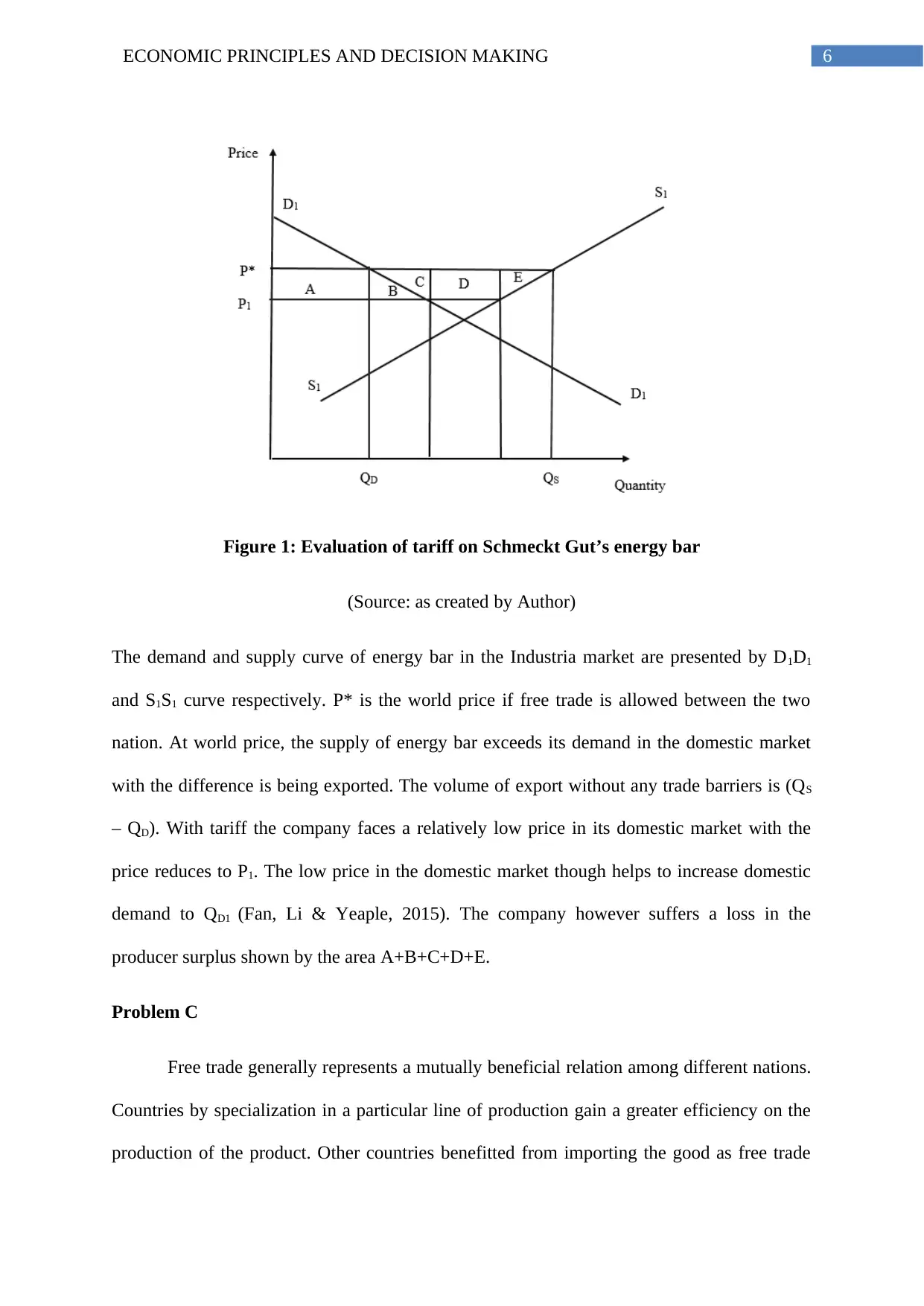
6ECONOMIC PRINCIPLES AND DECISION MAKING
Figure 1: Evaluation of tariff on Schmeckt Gut’s energy bar
(Source: as created by Author)
The demand and supply curve of energy bar in the Industria market are presented by D1D1
and S1S1 curve respectively. P* is the world price if free trade is allowed between the two
nation. At world price, the supply of energy bar exceeds its demand in the domestic market
with the difference is being exported. The volume of export without any trade barriers is (QS
– QD). With tariff the company faces a relatively low price in its domestic market with the
price reduces to P1. The low price in the domestic market though helps to increase domestic
demand to QD1 (Fan, Li & Yeaple, 2015). The company however suffers a loss in the
producer surplus shown by the area A+B+C+D+E.
Problem C
Free trade generally represents a mutually beneficial relation among different nations.
Countries by specialization in a particular line of production gain a greater efficiency on the
production of the product. Other countries benefitted from importing the good as free trade
Figure 1: Evaluation of tariff on Schmeckt Gut’s energy bar
(Source: as created by Author)
The demand and supply curve of energy bar in the Industria market are presented by D1D1
and S1S1 curve respectively. P* is the world price if free trade is allowed between the two
nation. At world price, the supply of energy bar exceeds its demand in the domestic market
with the difference is being exported. The volume of export without any trade barriers is (QS
– QD). With tariff the company faces a relatively low price in its domestic market with the
price reduces to P1. The low price in the domestic market though helps to increase domestic
demand to QD1 (Fan, Li & Yeaple, 2015). The company however suffers a loss in the
producer surplus shown by the area A+B+C+D+E.
Problem C
Free trade generally represents a mutually beneficial relation among different nations.
Countries by specialization in a particular line of production gain a greater efficiency on the
production of the product. Other countries benefitted from importing the good as free trade
Paraphrase This Document
Need a fresh take? Get an instant paraphrase of this document with our AI Paraphraser
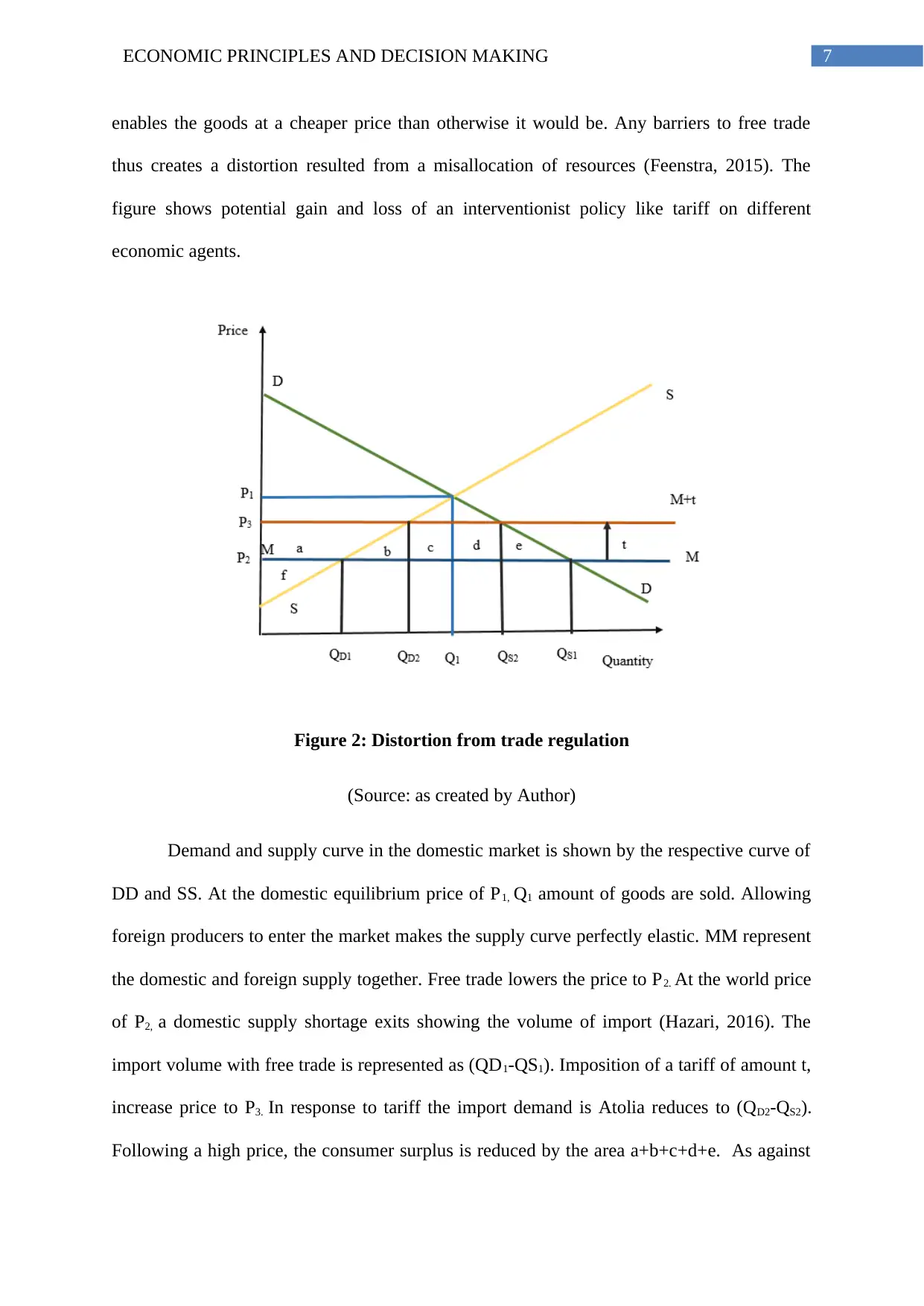
7ECONOMIC PRINCIPLES AND DECISION MAKING
enables the goods at a cheaper price than otherwise it would be. Any barriers to free trade
thus creates a distortion resulted from a misallocation of resources (Feenstra, 2015). The
figure shows potential gain and loss of an interventionist policy like tariff on different
economic agents.
Figure 2: Distortion from trade regulation
(Source: as created by Author)
Demand and supply curve in the domestic market is shown by the respective curve of
DD and SS. At the domestic equilibrium price of P1, Q1 amount of goods are sold. Allowing
foreign producers to enter the market makes the supply curve perfectly elastic. MM represent
the domestic and foreign supply together. Free trade lowers the price to P2. At the world price
of P2, a domestic supply shortage exits showing the volume of import (Hazari, 2016). The
import volume with free trade is represented as (QD1-QS1). Imposition of a tariff of amount t,
increase price to P3. In response to tariff the import demand is Atolia reduces to (QD2-QS2).
Following a high price, the consumer surplus is reduced by the area a+b+c+d+e. As against
enables the goods at a cheaper price than otherwise it would be. Any barriers to free trade
thus creates a distortion resulted from a misallocation of resources (Feenstra, 2015). The
figure shows potential gain and loss of an interventionist policy like tariff on different
economic agents.
Figure 2: Distortion from trade regulation
(Source: as created by Author)
Demand and supply curve in the domestic market is shown by the respective curve of
DD and SS. At the domestic equilibrium price of P1, Q1 amount of goods are sold. Allowing
foreign producers to enter the market makes the supply curve perfectly elastic. MM represent
the domestic and foreign supply together. Free trade lowers the price to P2. At the world price
of P2, a domestic supply shortage exits showing the volume of import (Hazari, 2016). The
import volume with free trade is represented as (QD1-QS1). Imposition of a tariff of amount t,
increase price to P3. In response to tariff the import demand is Atolia reduces to (QD2-QS2).
Following a high price, the consumer surplus is reduced by the area a+b+c+d+e. As against
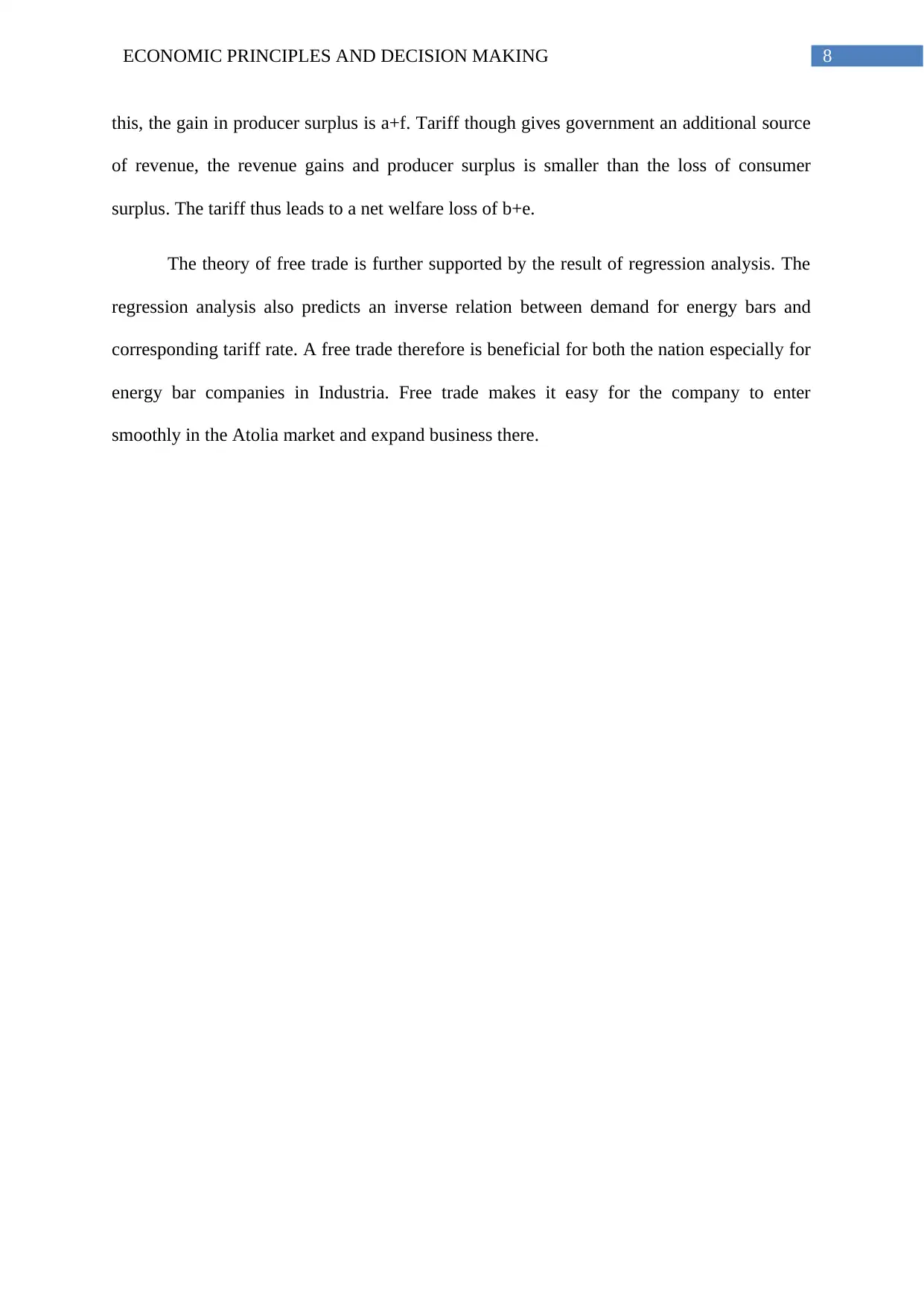
8ECONOMIC PRINCIPLES AND DECISION MAKING
this, the gain in producer surplus is a+f. Tariff though gives government an additional source
of revenue, the revenue gains and producer surplus is smaller than the loss of consumer
surplus. The tariff thus leads to a net welfare loss of b+e.
The theory of free trade is further supported by the result of regression analysis. The
regression analysis also predicts an inverse relation between demand for energy bars and
corresponding tariff rate. A free trade therefore is beneficial for both the nation especially for
energy bar companies in Industria. Free trade makes it easy for the company to enter
smoothly in the Atolia market and expand business there.
this, the gain in producer surplus is a+f. Tariff though gives government an additional source
of revenue, the revenue gains and producer surplus is smaller than the loss of consumer
surplus. The tariff thus leads to a net welfare loss of b+e.
The theory of free trade is further supported by the result of regression analysis. The
regression analysis also predicts an inverse relation between demand for energy bars and
corresponding tariff rate. A free trade therefore is beneficial for both the nation especially for
energy bar companies in Industria. Free trade makes it easy for the company to enter
smoothly in the Atolia market and expand business there.
⊘ This is a preview!⊘
Do you want full access?
Subscribe today to unlock all pages.

Trusted by 1+ million students worldwide
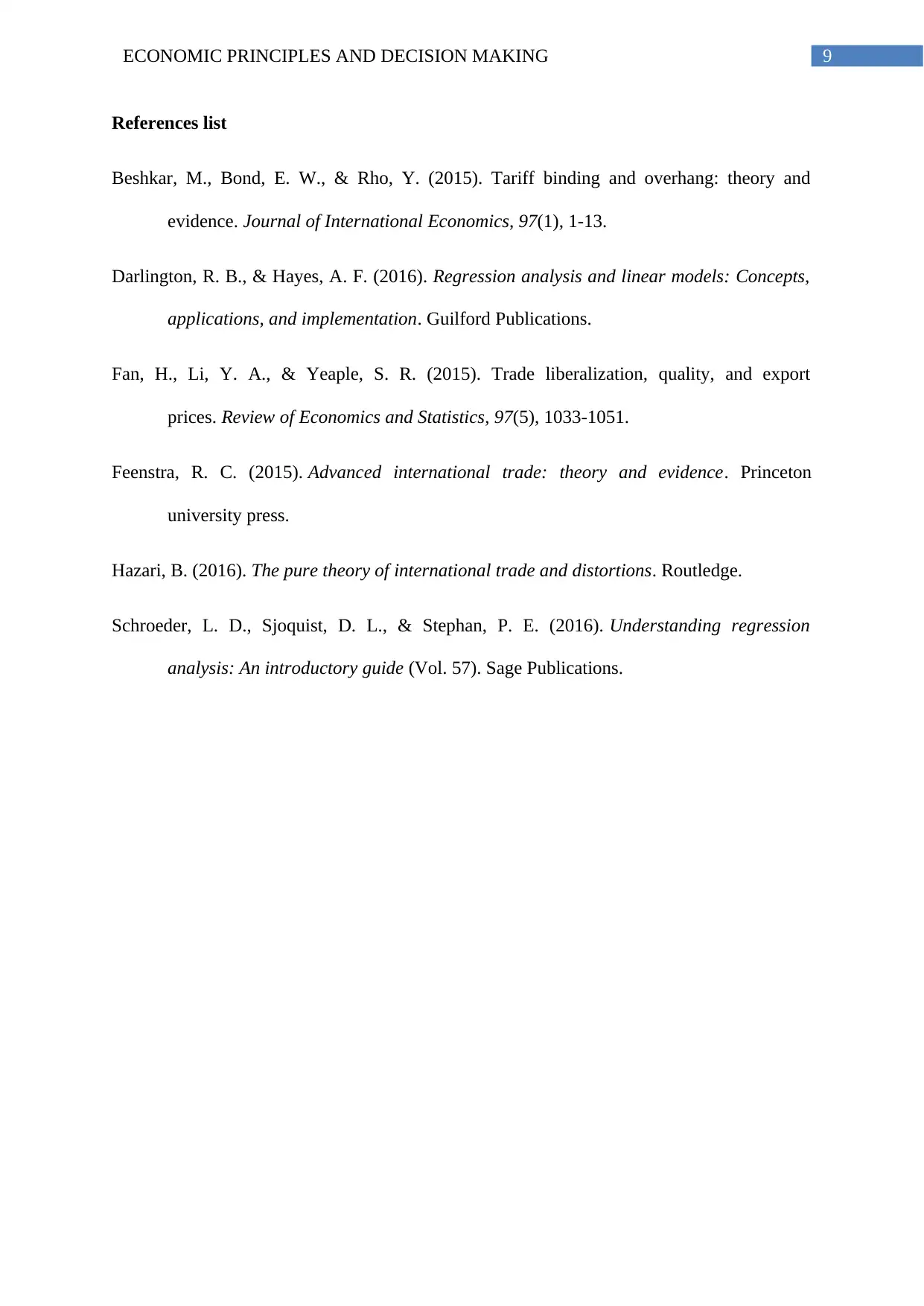
9ECONOMIC PRINCIPLES AND DECISION MAKING
References list
Beshkar, M., Bond, E. W., & Rho, Y. (2015). Tariff binding and overhang: theory and
evidence. Journal of International Economics, 97(1), 1-13.
Darlington, R. B., & Hayes, A. F. (2016). Regression analysis and linear models: Concepts,
applications, and implementation. Guilford Publications.
Fan, H., Li, Y. A., & Yeaple, S. R. (2015). Trade liberalization, quality, and export
prices. Review of Economics and Statistics, 97(5), 1033-1051.
Feenstra, R. C. (2015). Advanced international trade: theory and evidence. Princeton
university press.
Hazari, B. (2016). The pure theory of international trade and distortions. Routledge.
Schroeder, L. D., Sjoquist, D. L., & Stephan, P. E. (2016). Understanding regression
analysis: An introductory guide (Vol. 57). Sage Publications.
References list
Beshkar, M., Bond, E. W., & Rho, Y. (2015). Tariff binding and overhang: theory and
evidence. Journal of International Economics, 97(1), 1-13.
Darlington, R. B., & Hayes, A. F. (2016). Regression analysis and linear models: Concepts,
applications, and implementation. Guilford Publications.
Fan, H., Li, Y. A., & Yeaple, S. R. (2015). Trade liberalization, quality, and export
prices. Review of Economics and Statistics, 97(5), 1033-1051.
Feenstra, R. C. (2015). Advanced international trade: theory and evidence. Princeton
university press.
Hazari, B. (2016). The pure theory of international trade and distortions. Routledge.
Schroeder, L. D., Sjoquist, D. L., & Stephan, P. E. (2016). Understanding regression
analysis: An introductory guide (Vol. 57). Sage Publications.
1 out of 10
Related Documents
Your All-in-One AI-Powered Toolkit for Academic Success.
+13062052269
info@desklib.com
Available 24*7 on WhatsApp / Email
![[object Object]](/_next/static/media/star-bottom.7253800d.svg)
Unlock your academic potential
Copyright © 2020–2025 A2Z Services. All Rights Reserved. Developed and managed by ZUCOL.




